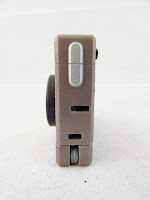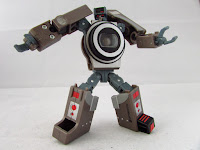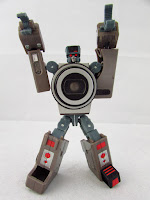All things considered, when Hasbro decided to launch a range of TransFormers toys modelled after real-world electronic devices, my thoughts and feelings tend toward "what took them so long?". Micro Change had been part of the foundation of the brand, back in the early 1980s, but the focus turned more toward vehicles as the line progressed... These toys might have been in development alongside the Cybertron/Galaxy Force line, but it took the 2007 live action movie to shift focus back. By positing that our technological leaps in electronics had been achieved by reverse engineering Megatron, the movie gave these toys some context.
Given the number of electronic devices already in the TransFormers back catalogue, one might have expected a new take on Soundwave or Reflector... but the closest we got to the former was Booster X10 - a clear reference to Laserbeak - and the closest we got to the latter... would be this little fellow.
But, of course, cameras have got substantially smaller since the 1980s, what with the digital revolution, and all... and just 15 years after this toy appeared, many people believe cameras, per se, to have been made redundant by those built into cellphones... So let's take a look at this relic of the past, and see how it works as a TransFormers toy.
Back when I first started this blog, I was using a 3.3 megapixel Sony Cybershot DSC-S75 for all the photographs, and that hulking beast positively dwarfed this slimline, compact piece of kit. I later switched to the Fujifilm FinePix J20, which offered a whopping 10.0 megapixel resolution, but had a really hard time with close-up shots. It had a broadly similar appearance to Spyshot 6, but was still somewhat larger. For its time, though, this toy was a reasonably accurate representation of the new wave of pocket-sized digital cameras.
The front features the extending lens barrel which looks quite convincing (albeit nonfunctional, and stuck at a few millimetres of extension), and a small, integrated flash lamp. The lens sits within a wide, sliver-painted frame, and there's a set of six raised circles on the left side, painted silver and leading down to a tampograph of the Autobot insignia and the name 'Spyshot 6', as the camera's branding. The left side features some sort of button control, though I can't think what it would be, given that the zoom control is on the back, marked with the standard W | T buttons. There's also a directional (menu) controller and some kind of circular dial toward the righthand side, with an old-fashioned analogue viewfinder to complement the digital viewfinder screen, which is represented by a sticker showing Cybertron Ransack/Galaxy Force Gasket - a reminder that, while these toys were released alongside the first movie's toylines, and in similar packaging, they were developed much earlier. Below the screen are a couple of directional buttons. Dotted around the back are some circular details, as a result of the toy's screw holes being covered with plastic discs, glued into place. Most of them sit flush with the back of the camera, but the one directly below the analogue viewfinder on my copy juts out very slightly, almost looking like an unpainted button.
While some of the buttons on this toy are sculpted and painted on the base metallic brownish-grey plastic, others are separate black plastic parts, glued in place. This feels more than a little disappointing, despite it being in keeping with the rest of the Real Gear Robots line and, as with High Score 100, I find myself wishing there was some movement in at least some of them. The actual shutter button amounts to this mode's only real play feature, and returns a satisfying click when pressed... Most of the time, that is... Every so often it jams in its depressed state, but normally pops back out with another press.







Robot Mode:
When it comes to design - generally, not just of transforming alien robots - I am a huge fan of asymmetry... Which is probably a good thing where Spyshot 6 is concerned, because his robot mode is a bit of a jumble. He ends up with arms of different sizes and legs that end in completely mismatched feet, resulting in a somewhat thrown-together appearance. That's not to say his construction doesn't make sense - quite the opposite - and I really like the fact that his flashbulb sits on one shoulder, though there's no way of knowing if it's intended as a simple lamp, or some kind of offensive weapon. The lower legs both look like huge moon boots, but have been handled surprisingly well for his size. The right foot is formed from an irregularly-shaped chunk of the camera and has a hole in the top to accommodate one of his hands in camera mode, while the left folds out from a more regular, rectangular chunk. Both shins feature the same sculpted details and paint applications (albeit with minor variations on the right due to some protruding tabs at the knee), and then the transformation allows for the round, black plastic camera mode features to end up on the outer faces of each lower leg... So, on the one hand, the designers leaned into the asymmetry but, on the other hand, they also tried to mitigate it. The end result is fairly effective, within those limitations. Probably the weakest parts of this robot are the body mass - the camera's lens on the front, the digital display on the back - the forearms, the pelvis and the upper legs.
While, obviously, a digital camera will have electronics behind its shutter, rather than the traditional pinhole to a roll of film, it still seems really weird for a robot to have a lens apparently occupying most of its torso. Viewfinder, of the original G1 Reflector set, really only got away with it because the built in lens/shutter section was proportionally smaller on the robot due to the way analogue cameras were built. But, if that wasn't bad enough, the fact that he has a digital display on his back - one that is permanently showing an image of Ransack/Gasket - almost makes it look as though he's a back-to-front robotic Teletubby... Of course, due to the way he's built, he can be flipped round so the display is on his front and the lens is on the back... but that's really not any better.
The forearms suffer by being comparatively plain, with the both featuring fairly nondescript detailing. The right arm probably comes off the worst, because it appears to have the head of a hammer sculpted into it, and there are two screws just in front of the elbow. He's also another robot with claws rather than decent hands but, on the upside, these claws are at least poseable - each one able to fully open or, when closed, tilt up and down. Between the waist and the knees, he gets a little odd. For starters, the thighs seem disproportionately small and, like the forearms, are comparatively featureless due to their small size. It's the handling of the pelvis that really doesn't seem to make sense, though. One would tend to expect a complete, contiguous pelvic area, like most TransFormers toys would have, and per my photos below. It looks right, albeit while emphasising his weird proportions... The pelvis is split, however, and not in service of his transformation. The two halves actually click into place with a large gap between them, and filling out the sides of the waist. This looks less than optimal, but I'm forced to conclude that this is the correct or, at least, the intended configuration, however awkward it might appear.
Head sculpts in the Real Gear Robots line are all very hit-and-miss... and I can't quite decide which category Spyshot 6 falls into. On the one hand, the overall shape gives me the impression of the Universal Studios version of Frankenstein's monster, or of the robotic equivalent of an ushanka. He has a very humanoid face, painted gunmetal, with large, googly, impressively light-piped eyes, a protruding block on his chin and... I can't quite tell if the mouth has a big, cheesy grin, or just a large bottom lip. The head is molded in the same pale, vaguely metallic blue as most of his moving parts, while the top of the front is sculpted to somewhat resemble the flash on his left shoulder (behind which the head sits in camera mode), but then painted black, with a red line over the left eye. It's an odd head sculpt... but certainly not my least favourite in the line.













Spyshot 6 has a relatively simple transformation, with the head and arms tilting round by about 30° clockwise, then compressing in to form the top and left side of the camera (when viewed from behind), while the legs shift round 90° clockwise, then compress in to complete the bottom and right side of the camera, with the foot folding up into the right side. The hands tuck in easily enough, but there are clearance issues with the elbows, and if feels weird to leave a thin sliver of his head exposed through a slot above the flash. The legs are odd, partly because of the aforementioned - and largely unnecessarily - split pelvis, but also because there's a transformation hinge perpendicular to the knee joint, that's used in conjunction with both the knee and the hip to complete transformation.
For a figure of this small size, released in 2007, Spyshot 6 has decent articulation. While he lacks the contemporary luxury of ankle joints, the knees have excellent range due to transformation, managing well over 90° before butting up against the inner part of his hip joints. There's a swivel joint immediately above the knee, also due to transformation, and the ball-jointed hips have 180° of travel from front to back, a little over 90° out to the sides, as well as a little rotation on the ball joint. As far as the legs go, he can adopt some reasonably dynamic poses, and the extremely flat footprint makes it fairly easy to stand him on one leg. The arms are mounted on ball joints that are then hinged at the base, so they can swing a full 360° around the shoulder, butterfly very slightly, as well as being able to shrug a little. Their asymmetry means that outward movement is inconsistent, and the only way the left arm can move substantially is by obscuring his head. His left elbow is hinged, with a ball joint just above, while the right elbow is a simple ball joint in the forearm, and a little on the loose side. As mentioned above, the claws can open, as well as tilt at the wrist. The head is mounted on a ball joint, offering unrestricted rotation, and a range of about 90° tilt foward-to-backward... though the head has a tendency to pop back to the vertical when pushed forward. He's also got a tiny bit of sideways tilt, but it favours tilting to the left, possibly as a result of his transformation.
In spite of his extremely odd appearance, I'd have to rate Spyshot 6 as one of my favourite Real Gear Robots. Part of that is simply because his camera mode is so much fun - it looks reasonably convincing, and the shutter button is utterly compulsively clickable. His robot mode appeals to me because he wears his asymmetry so well, giving him a lot of character. He may not be the greatest TransFormers toy of all time, and I might have preferred a few more 'pressable' controls on the camera but, for his size and for the time, he's a pretty decent toy.

No comments:
Post a Comment